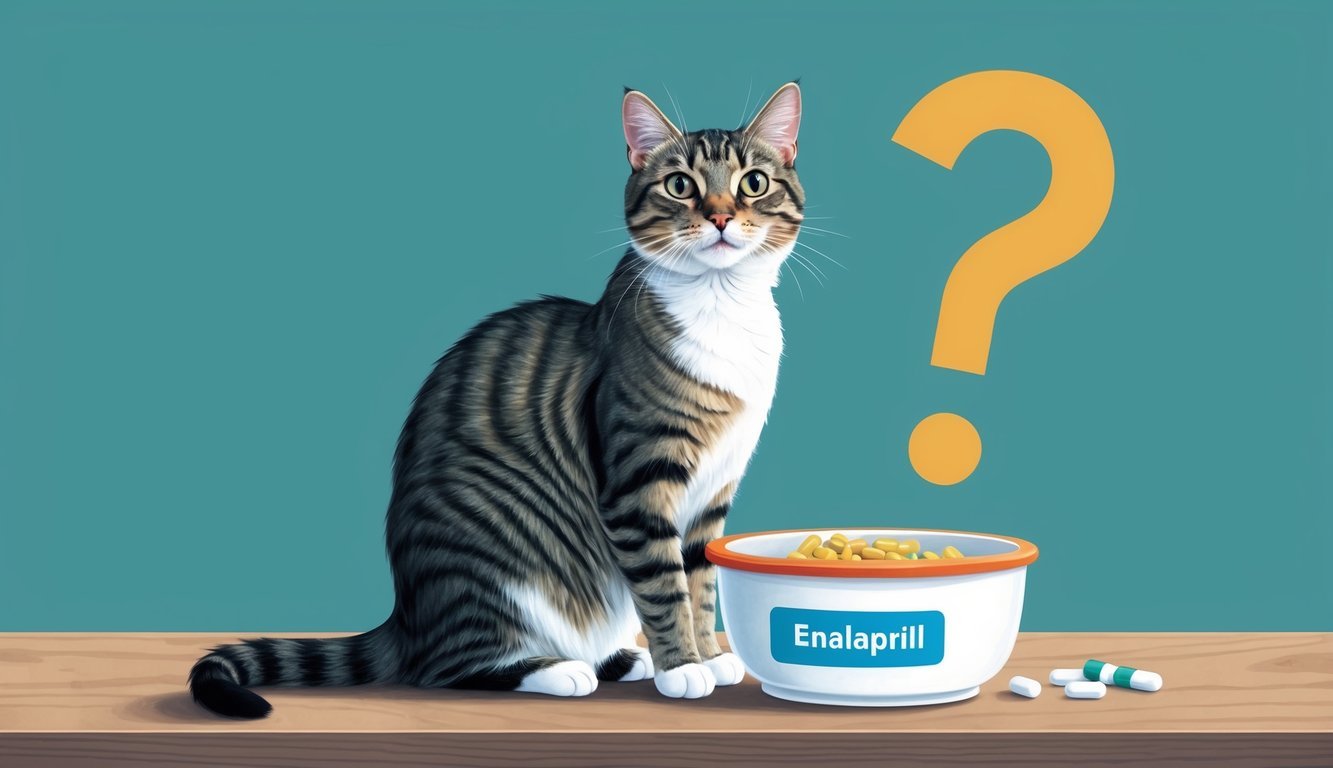Enalapril is a vital medication that can help improve the health of your cat, especially if they are facing issues like heart failure, high blood pressure, or kidney disease. This ACE inhibitor works by relaxing blood vessels, which helps to lower blood pressure and enhance blood flow to critical organs. If your cat has been diagnosed with any of these conditions, knowing how enalapril works and its benefits can make a significant difference in their quality of life.
As a pet owner, it’s essential to stay informed about the medications your furry friend may need.
Enalapril could help alleviate symptoms such as coughing and difficulty breathing, giving your cat a better chance at a comfortable life.
You might wonder about potential side effects or how to administer this medication properly—understanding these factors will ensure you can make the best decisions for your pet’s health.
With proper guidance from your veterinarian, enalapril can be a game-changer for managing your cat’s health issues.
This article will explore everything you need to know about enalapril, including its uses, benefits, and considerations.
Key Takeaways
- Enalapril can significantly improve heart function and manage blood pressure in cats.
- Administration of enalapril should be guided by your veterinarian for safety and effectiveness.
- Awareness of potential side effects is crucial for ensuring your cat’s well-being while on this medication.
Understanding Enalapril

Enalapril is an important medication for managing various heart and blood pressure issues in cats.
This section breaks down what enalapril is, how it functions within the body, and its applications in veterinary medicine.
What Is Enalapril?
Enalapril is classified as an ACE inhibitor, which stands for angiotensin-converting enzyme inhibitor.
This type of medication is designed to block an enzyme responsible for constricting blood vessels.
By doing so, it relaxes the blood vessels and helps improve blood flow.
It was initially developed for humans but is widely used in veterinary practices, particularly for cats.
It has been approved by the FDA for veterinary use under certain conditions.
Understanding its role in managing health issues in your cat is essential for effective treatment.
How Enalapril Works
Enalapril primarily works by inhibiting the production of angiotensin II, a powerful vasoconstrictor.
When this enzyme is blocked, blood vessels dilate, leading to improved circulation and reduced blood pressure.
With decreased resistance in the vascular system, your cat’s heart doesn’t have to work as hard.
This makes enalapril an effective option for conditions like hypertension and heart failure.
The medication not only enhances blood flow but also reduces fluid buildup in the lungs and other organs.
Enalapril in Veterinary Use
In veterinary medicine, enalapril is particularly useful for treating high blood pressure and heart failure.
Veterinarians may prescribe it when other medications, such as amlodipine, have not sufficiently controlled blood pressure.
Enalapril is also indicated for managing chronic kidney disease and can help reduce protein loss in urine, a condition known as proteinuria.
When properly dosed, this medication can make a significant difference in your cat’s quality of life.
Always follow your veterinarian’s guidelines when administering enalapril to ensure your cat receives the correct dosage and monitoring.
Benefits of Enalapril for Cats
Enalapril offers several significant benefits for cats, particularly in managing heart conditions and supporting kidney function.
By improving blood flow and reducing symptoms of heart disease, this medication can enhance your cat’s quality of life.
Managing Heart Conditions
If your cat suffers from heart disease or congestive heart failure, Enalapril can be a crucial part of their treatment plan.
As an angiotensin-converting enzyme (ACE) inhibitor, it helps to relax blood vessels.
This action reduces blood pressure, making it easier for the heart to pump blood effectively.
By lowering blood pressure, Enalapril can decrease the workload on the heart.
Cats may experience relief from symptoms like coughing or difficulty breathing.
Regular use can lead to improved heart function and overall vitality.
Always consult your vet to determine the appropriate dosage for your cat’s specific situation.
Supporting Kidney Function
Enalapril doesn’t just support heart health; it also plays a role in kidney function.
For cats with chronic kidney disease or kidney dysfunction, this medication can increase kidney blood flow.
The improved circulation supports kidney function and can help manage symptoms associated with these conditions.
By enhancing blood flow, Enalapril aids in the removal of waste products from the bloodstream.
This benefit can be particularly vital for cats struggling with changes in appetite or energy levels.
Monitoring your cat during treatment is essential, as your vet may adjust the dosage based on their response to the medication.
Administering Enalapril

Administering Enalapril to your cat involves careful attention to dosage and regular monitoring.
You’ll want to ensure your furry friend receives the right amount while keeping an eye on their health throughout the treatment.
Dosage Guidelines
The dosage of Enalapril can vary based on your cat’s weight, health condition, and response to the medication.
Typically, Enalapril comes in tablet form (2.5 mg, 5 mg, 10 mg, and 20 mg) or as an oral solution.
For cats, the usual starting dose is around 0.5 mg/kg given once or twice daily.
Your veterinarian will help determine the precise dosage that’s safe for your pet.
It’s crucial to administer the medication consistently, at the same time each day.
Always follow your vet’s tailored instructions.
Treatment Plan and Monitoring
Establishing a treatment plan with your veterinarian is important.
This typically includes regular blood tests to monitor kidney function and any potential side effects.
During the treatment period, look for signs of vomiting or diarrhea, as these may indicate a reaction to the medication.
If you notice these symptoms or any changes in behavior, contact your vet promptly.
In some cases, your veterinarian may recommend combining Enalapril with other medications, like Benazepril or Amlodipine, especially for managing hypertension.
Regular follow-ups will ensure the effectiveness of the treatment plan and allow for any necessary adjustments.
Potential Side Effects and Risks

When considering enalapril for your cat, it’s essential to be aware of both common side effects and potential serious health concerns.
These reactions can vary, and being informed will help you monitor your pet’s health effectively.
Common Side Effects
Some side effects of enalapril are relatively common and may occur during treatment.
You might notice:
- Loss of Appetite: Decreased interest in food can be a sign your cat is feeling unwell.
- Vomiting and Diarrhea: These gastrointestinal issues can lead to dehydration, so keep an eye on your cat’s water intake.
- Lethargy and Weakness: If your cat seems unusually tired or weak, it’s something to report to your veterinarian.
While these symptoms can be concerning, they might not indicate a severe problem.
However, it’s crucial to monitor them and contact your vet if they persist.
Serious Health Concerns
While most cats tolerate enalapril well, there are serious risks to consider.
Some potential health concerns include:
- Kidney Failure: Enalapril alters kidney blood flow, and monitoring is essential to prevent serious dysfunction.
- Hypotension: Low blood pressure can occur and may lead to weakness or fainting episodes.
- Allergic Reactions: Symptoms like itching or swelling can indicate a hypersensitivity to the medication.
In rare cases, an overdose may lead to severe complications, including changes in potassium levels or liver issues.
If you observe any severe reactions, seek veterinary assistance immediately.
Important Considerations
When considering enalapril for your cat, it’s essential to be aware of potential drug interactions and the suitability of this medication for specific populations.
Understanding these factors can make a significant difference in your cat’s health and treatment outcomes.
Drug Interactions and Contraindications
Enalapril can interact with several medications, which is crucial when planning your cat’s treatment.
Notably, combining it with diuretics such as furosemide or spironolactone may enhance the risk of hypotension.
This effect occurs because diuretics increase urine production, leading to lower blood volume and pressure.
Additionally, concurrent use with NSAIDs can reduce the effectiveness of enalapril and may negatively influence kidney function.
Always monitor your cat’s blood potassium levels since enalapril can elevate these.
If your cat is already on a potassium-sparing diuretic, this could lead to hyperkalemia, which is dangerous.
Inform your veterinarian about all medications and supplements your cat is taking.
Special Populations
Certain populations require special attention when using enalapril.
For example, cats that are pregnant or lactating should generally avoid this medication.
The safety of enalapril during these stages is not well-established, and it could pose risks to developing kittens.
Moreover, geriatric cats or those with existing kidney disease may need adjusted dosages and careful monitoring.
Their bodies may not process the medication efficiently, increasing the likelihood of side effects.
Always consult your veterinarian to determine the safest and most effective dosage for your cat’s specific conditions.
Enalapril vs. Other Treatments
When considering enalapril for your cat, it’s essential to evaluate how it compares to other treatment options.
Understanding the different classes of medications and their applications can help you make informed choices for your cat’s health.
Comparing ACE Inhibitors
ACE inhibitors like enalapril and benazepril both target the angiotensin-converting enzyme to help manage conditions like high blood pressure and proteinuria.
While enalapril is often used for treating heart failure, vasotec (an alternative name for enalapril) also works well in cases of renal disease.
Some vets prefer benazepril over enalapril due to its longer half-life, which allows for once-daily dosing.
This can be more convenient for you and may help maintain stable blood pressure throughout the day.
Both drugs have similar side effects, such as potential hypotension.
Regular monitoring of blood pressure can help ensure your cat remains stable while on either medication.
Combined Therapies
Combining enalapril with other treatments can enhance its effectiveness.
For example, your vet might recommend pairing enalapril with diuretics in cases of heart failure.
This combination can help reduce fluid overload while managing blood pressure.
Using enalapril in conjunction with dietary adjustments can also be beneficial.
Lowering sodium intake can amplify the drug’s effects, aiding in better blood pressure control.
Remember, any combined therapy should be discussed with your veterinarian to create a tailored treatment plan.
Frequently Asked Questions

When considering enalapril for your cat, you might have some common questions.
This section addresses important concerns about dosage, side effects, kidney health, and the medication’s effectiveness for specific conditions.
What’s the recommended dosage of enalapril for my cat?
The dosage of enalapril for cats typically ranges from 0.25 to 0.5 mg per kilogram of body weight, given once or twice daily.
Your veterinarian will determine the exact dosage based on your cat’s specific health needs and conditions.
Can my kitty experience any side effects from taking enalapril?
Yes, cats may experience side effects such as lethargy, decreased appetite, or gastrointestinal upset.
It’s crucial to monitor your cat for any unusual behavior and discuss potential side effects with your veterinarian.
Is enalapril safe for a cat with kidney issues?
Enalapril can be prescribed for cats with kidney issues, but caution is necessary.
Your veterinarian should evaluate your cat’s overall health and existing conditions before starting treatment.
Will enalapril help my cat’s heart murmur?
Enalapril can be beneficial in managing heart murmurs related to heart failure or high blood pressure.
It helps improve blood flow by relaxing blood vessels, which can alleviate some symptoms.
How does enalapril actually help with congestive heart failure in cats?
In cases of congestive heart failure, enalapril works by inhibiting the angiotensin-converting enzyme.
This reduction in blood vessel constriction lowers blood pressure and decreases the heart’s workload, improving circulation and overall function.
What should I do if I think my cat’s had too much enalapril?
If you suspect an overdose, contact your veterinarian immediately.
Symptoms of an overdose may include excessive drooling, vomiting, or lethargy.
Make sure your cat receives appropriate care by seeking prompt medical attention.

